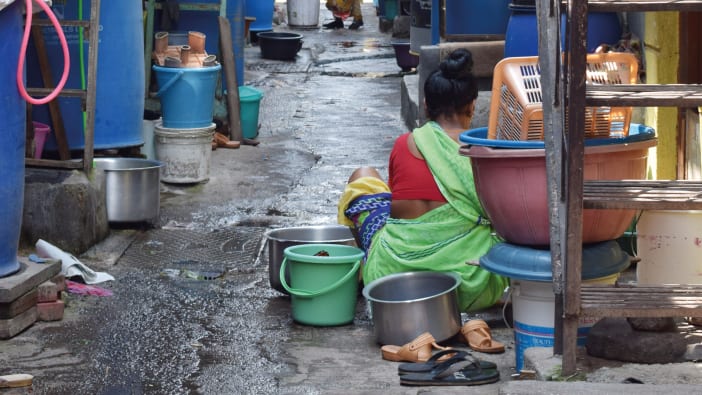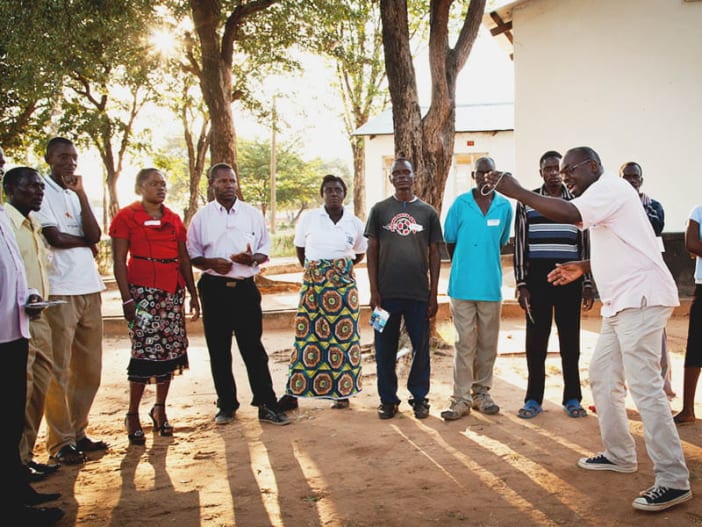When Drs Rajanikant and Mabelle Arole graduated from medical school they were both concerned about the medical care of the rural population of India. They went to work in a rural hospital. After five years they realised that despite all their hard work in caring for hospital patients, the general health of the community around had not improved. They realised their need for training in public health and returned to college for further study.
In 1970 they began working in the village of Jamkhed, Maharastra State, India. Jamkhed was officially classified as ‘backward’. There was a huge need for medical care. The economy is based on agriculture, with women making up 70% of the labour force. About 60% of the population are poor, landless farmers. The caste system is very strong in the area and about 20% of the population are ‘untouchables’. The doctors continue their story themselves…
Before starting any medical work, we spent 6–8 months meeting people and making contacts. To ensure genuine community participation, enough time must be spent with the community so that people are informed and clear about what is needed to improve their health.
When you spend time with people, you realise they are much more concerned about food and water than health. Instead of beginning to set up medical services, we first helped with improving people’s agriculture and water supply. People want to ensure their livelihood. Community participation can only be ensured when people are organised around something that is vital to them. We could not have organised people around health. We could not ask people to come, saying ‘Let’s have a talk on how to clean your teeth.’ Nobody would come. But if you say ‘Look, over a third of your children are malnourished. Let us teach you how to boost your agriculture’, people will want to come.
The real cause of ill health is poverty and the lack of resources to provide a livelihood.
Assessing the situation
Before beginning medical services we carried out surveys. We found malnutrition in under-fives and pregnant mothers and a need for family planning. We found certain chronic illnesses – tuberculosis, leprosy and blindness, for example. So these were the problems. We based our curative health care on these results. If you are caring for a pregnant mother – what problems may she have? She may bleed, so blood transfusion services are needed. She may need a caesarean section, so you need a simple operating theatre and someone to give anaesthetics. If just one woman out of the many being cared for by the primary health team needs a caesarean section, but there is no facility for referring her, then the whole ante-natal programme suffers.
Primary health care will be successful if you have a proper referral service. The number of patients actually referred will be small but their needs must be met, or the whole health programme suffers.
Local abilities
At first we depended on nurses to liaise between villagers and the CRHP services and to help with social changes. But we were soon disappointed. The nurses were not happy living alone in remote villages and there remained a barrier between them and the villagers because of their education.
The first important change in our thinking came when the villagers suggested that we train village women to be health workers. At that time we believed that only doctors should be treating illnesses. However, as the villagers began to trust their own abilities, they asked if we could teach them to deliver babies. We taught them and they became very good at it. Then we taught them about family planning and they became very good at this too. This was when our whole idea about the capabilities of illiterate village people began to change. We changed our approach and began training village women as health workers.
Social change
The result has been a catalyst for social change. At first, social issues like the status of women and the caste system were new to us. We deliberately chose to work with the poor, the lower castes and with women. We made sure, for example, that the ‘Food for Work’ programme was managed by the poor people. For centuries the ‘untouchables’ had never had an opportunity to take part in decision-making. Now they might be in charge of programmes with up to 2,000 people. Never before had they had such decision-making power! The local elite were not happy at all. The only reason we survived was because we were skilled as doctors and the elite knew they would lose good doctors!
Health and the caste system
Sitting wells to provide drinking water was another interesting situation. Where do you place the tube well? The higher castes wanted the wells in their area, but then lower castes would be unable to draw water. So we asked the geologist to go around the whole village testing, but always to make sure the well was eventually sited in the ‘untouchables’ area! Over several months we put in 140 wells. Only later did the high caste people realise what had happened. We now realise social change plays a major role in changing the health of the people.
At first, caste problems prevented participation in the health training. The higher caste women refused to sit with low caste women. So we made them cook together. We had them sleep on the floor on a big carpet and covered them with a single blanket. We asked them ‘Haven’t we all got the same kind of blood?’ ‘Don’t we all have the same kind of heart?’ Change came slowly.
Jamkhed training centre
At first we provided informal training. As time passed we were asked to do more training for other health organisations and for the government. Last year we established an international training centre for Primary Health Care. Most health training is theoretical. But here we give practical training involving the community. Half of our time is spent on technical teaching but the other half is spent on developing values. This is where the Christian message comes in. Development without the right values and motivation is meaningless.
The Jamkhed values are…
Love – Love is fundamental and it is love that serves. Service is a great social power to change communities.
Humility – We need humility in order to accept and serve the unlovely, the poor and the deprived.
Hope – in the transformation of individuals and communities encourages us to persevere in working with difficult people in difficult situations.
Faith – in God helps to share God’s goodness with all his children.
The whole concept of community health care is not about providing ‘things’ but about changing attitudes. The development of the human person must come first – health and agriculture come second. Other organisations which try to imitate the Jamkhed training often fail because these organisations themselves do not have the right attitudes to the poor.
Training course details
The courses in Jamkhed are made up of three parts…
- initial three month training
- six month supervised work practice
- final one week assessment.
During the first three months, trainees develop a realistic Action Plan to be carried out in their own area. Course tutors visit all trainees at least once during their six months of work practice to assess how their Action Plan is working out. During the final week, participants make a presentation about their work.
Certificates are presented at the end of the whole course.
The proportion of time spent on studying health and development is equally divided. Training is learner centred and participatory. Group work is encouraged. Participants are encouraged to apply theory to practice at all times. Field visits, attachments to health workers, case studies, role play and time for reflection are all important.
The course is divided into five modules…
Community Based Health and Development
Skills Development – including counselling, communicating, leadership, facilitating groups and time management
Management – organisation, team building, monitoring and evaluation
Information Systems – including data collection and analysis
Finance and Budgeting – fund raising and writing project proposals.
Our objective is to produce leaders who will enable communities to take care of their own health. Emphasis is on providing skills in good leadership and on developing the right attitudes within the trainees to enable them to help communities bring about change.
With thanks to Contact, published by CMC – Churches Action for Health, WCC for permission to include information from their May 1993 issue. Drs R & M Arole work at CRHP, Jamkhed – 413201, District Ahmednagar, India.









